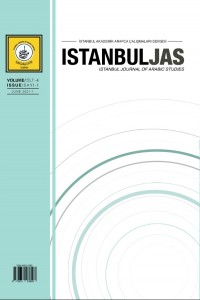Öz
Anahtar Kelimeler
مهارة الاستماع بالعربية صعوبات الاستماع كلمات مسموعة التعرف على الأصوات العربية منصة دينغ تولك الطلاب الصينيون
Kaynakça
- Reference1 C. T. James Huang, Y. H. Audrey Li, & Simpson, A. (2014). The Handbook of Chinese Linguistics. Wiley-Blackwell.
- Reference2 Ding Talk website. (2014). Consulted the 02 2021, on https://www.dingtalk.com/en
- Reference3 Kouihi, S. (2019). The Challenges of learning Modern Standard Arabic as a Foreign Language in China (master thesis). Morocco.
- Reference4 Rara Saraswaty, D. (2018). LEARNERS’ DIFFICULTIES & STRATEGIES IN LISTENING COMPREHENSION. English Community Journal, 2(1), 139.152.
- Reference5 Shanbo, S. (2020). The Influence on Chinese Students' English Writing Caused by the Difference of Chinese and Western Thinking Model--to Analyse from The Perspective of Conceptual Fluency. Frontiers in Educational Research, 3(4), 6-10. doi:10.25236/FER.2020.030402
- Reference6 speedtestfixed. (2020, May). Consulted the 07 01, 2020, on https://www.speedtest.net/global-index#fixed
- Reference7 speedtestmobile. (2020, May). Consulted the 07 01, 2020, on https://www.speedtest.net/global-index#mobile
Çinli Öğrencilerin Arapça Ses Birimlerini Ayırt Etmeleri: Dinleme Zorlukları ve Kelime Tanıma Hataları
Öz
Anahtar Kelimeler
arapça dinleme becerisi dinleme zorlukları işitilebilir kelimeler arapça ses birimlerinin tanınması DingTalk platformu Çinli öğrenciler
Kaynakça
- Reference1 C. T. James Huang, Y. H. Audrey Li, & Simpson, A. (2014). The Handbook of Chinese Linguistics. Wiley-Blackwell.
- Reference2 Ding Talk website. (2014). Consulted the 02 2021, on https://www.dingtalk.com/en
- Reference3 Kouihi, S. (2019). The Challenges of learning Modern Standard Arabic as a Foreign Language in China (master thesis). Morocco.
- Reference4 Rara Saraswaty, D. (2018). LEARNERS’ DIFFICULTIES & STRATEGIES IN LISTENING COMPREHENSION. English Community Journal, 2(1), 139.152.
- Reference5 Shanbo, S. (2020). The Influence on Chinese Students' English Writing Caused by the Difference of Chinese and Western Thinking Model--to Analyse from The Perspective of Conceptual Fluency. Frontiers in Educational Research, 3(4), 6-10. doi:10.25236/FER.2020.030402
- Reference6 speedtestfixed. (2020, May). Consulted the 07 01, 2020, on https://www.speedtest.net/global-index#fixed
- Reference7 speedtestmobile. (2020, May). Consulted the 07 01, 2020, on https://www.speedtest.net/global-index#mobile
The Distinction of the Arabic Phonemes by Chinese Students: Listening Difficulties and Word Recognition Error
Öz
Anahtar Kelimeler
Arabic listening skill listening difficulties audible words recognition of arabic phonemes the DingTalk platform Chinese students
Kaynakça
- Reference1 C. T. James Huang, Y. H. Audrey Li, & Simpson, A. (2014). The Handbook of Chinese Linguistics. Wiley-Blackwell.
- Reference2 Ding Talk website. (2014). Consulted the 02 2021, on https://www.dingtalk.com/en
- Reference3 Kouihi, S. (2019). The Challenges of learning Modern Standard Arabic as a Foreign Language in China (master thesis). Morocco.
- Reference4 Rara Saraswaty, D. (2018). LEARNERS’ DIFFICULTIES & STRATEGIES IN LISTENING COMPREHENSION. English Community Journal, 2(1), 139.152.
- Reference5 Shanbo, S. (2020). The Influence on Chinese Students' English Writing Caused by the Difference of Chinese and Western Thinking Model--to Analyse from The Perspective of Conceptual Fluency. Frontiers in Educational Research, 3(4), 6-10. doi:10.25236/FER.2020.030402
- Reference6 speedtestfixed. (2020, May). Consulted the 07 01, 2020, on https://www.speedtest.net/global-index#fixed
- Reference7 speedtestmobile. (2020, May). Consulted the 07 01, 2020, on https://www.speedtest.net/global-index#mobile
Ayrıntılar
| Birincil Dil | Arapça |
|---|---|
| Konular | Dilbilim |
| Bölüm | Makaleler |
| Yazarlar | |
| Yayımlanma Tarihi | 14 Haziran 2021 |
| Gönderilme Tarihi | 4 Mart 2021 |
| Kabul Tarihi | 26 Nisan 2021 |
| Yayımlandığı Sayı | Yıl 2021 Cilt: 4 Sayı: 1 |


